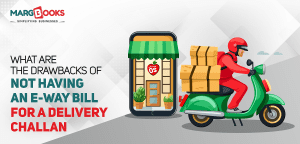In recent years, India’s Goods and Services Tax (GST) regime has brought in several technological advancements, one of which is the e-way bill system. The e-way bill plays a crucial role in simplifying the movement of goods while ensuring compliance with GST regulations. As a business owner, understanding the e-way bill system is vital for smooth operations and avoiding penalties. In this guide, we will explain the e-way bill system in detail, breaking it down step-by-step and offering practical tips for using online billing software and cloud-based accounting software to streamline your processes.
What is the E-Way Bill System?
The e-way bill system is an electronic document required for the movement of goods worth more than ₹50,000 within India. Under this system, businesses must generate an e-way bill through the GST portal before transporting goods. This bill serves as proof that the goods are being moved legally and compliantly under the GST law.
The e-way bill system applies to all kinds of goods, whether they are being transported within a state or across state borders. The system helps in curbing tax evasion, ensuring smooth logistics, and improving the efficiency of the supply chain.
How Does the E-Way Bill System Work?
The process of generating an e-way bill is straightforward and can be done online. Below is a step-by-step guide on how to generate an e-way bill:
Step 1: Registration on the GST Portal
Before generating an e-way bill, businesses must be registered under GST. Once registered, you can access the e-way bill system on the official GST portal.
Step 2: Log into the GST Portal
To generate an e-way bill, log into the GST portal using your credentials. Once logged in, navigate to the E-Way Bill section.
Step 3: Fill in the Details of the Goods and Transport
The next step is to fill in the details of the goods being transported. You need to enter information such as:
- GSTIN of the supplier and recipient
- Invoice or challan number
- Details of the goods: description, quantity, and value
- Transporter details: vehicle number, mode of transport, and other required info
Step 4: Generate the E-Way Bill
Once all the information is entered, click on Generate E-Way Bill. The system will generate a unique 12-digit e-way bill number, which is valid for the transportation of goods.
Step 5: Print or Share the E-Way Bill
Once the e-way bill is generated, it can be downloaded in PDF format or shared digitally with the transporter. It must accompany the goods during transportation.
Key Benefits of the E-Way Bill System
The introduction of the e-way bill system has brought several benefits to businesses, such as:
1. Reduced Fraud and Tax Evasion
The e-way bill system helps to reduce instances of tax evasion and illegal transportation of goods by ensuring that every movement of goods is tracked.
2. Improved Supply Chain Efficiency
With the e-way bill system, businesses can avoid delays at checkpoints, leading to faster transit times and a more efficient supply chain.
3. Real-Time Tracking
E-way bills allow businesses and tax authorities to track the movement of goods in real time, ensuring greater accountability.
4. Automated Compliance
The system automates compliance with GST regulations, making it easier for businesses to stay on the right side of the law.
When is the E-Way Bill Required?
E-way bills are mandatory when:
- The value of goods in transit exceeds ₹50,000.
- The goods are being transported from one state to another or within a state.
- The goods are being supplied to another person, whether for sale, job work, or any other purpose.
Exceptions to E-Way Bill Requirement
There are certain exemptions, including:
- Goods being transported for personal use
- Goods being transported by non-motorized vehicles
- Goods in transit that are exempted by the GST law
How to Streamline E-Way Bill Generation with Online Billing Software
While the process of generating an e-way bill is simple, managing it manually can become time-consuming, especially for large businesses with high volumes of transactions. This is where online billing software can be a game-changer.
With online billing software, you can seamlessly integrate the e-way bill generation process into your workflow. Features such as automated invoice creation, integration with GST portals, and real-time updates ensure that your e-way bills are generated without error.
Benefits of Using Online Billing Software:
- Automatic GST Calculation: Automatically calculates GST on sales and generates GST-compliant invoices.
- E-Way Bill Integration: Many online billing software tools allow direct integration with the e-way bill system, enabling automatic generation of e-way bills from invoices.
- Real-Time Updates: Track the status of your e-way bills and goods in real-time.
- Paperless and Efficient: Reduce paperwork and enhance business efficiency by digitizing your invoicing and e-way bill generation processes.
The Role of Cloud-Based Accounting Software in Managing E-Way Bills
To effectively manage your e-way bill system, businesses need more than just an invoicing solution. This is where cloud-based accounting software becomes essential.
Cloud-based accounting software allows business owners to manage their entire financial workflow, including inventory, sales, purchases, and taxes, all in one place. These platforms can also integrate with GST systems, automatically updating and filing returns, which ensures that your e-way bills are generated accurately and timely.
Key Benefits of Cloud-Based Accounting Software:
- Centralized Data: All your business data is stored in a secure cloud environment, easily accessible from anywhere, at any time.
- GST Compliance: Cloud-based software ensures that your business complies with the latest GST regulations, including the seamless generation of e-way bills.
- Integration with E-Way Bill System: Many cloud-based accounting platforms are integrated with the e-way bill system, reducing manual effort and ensuring compliance.
- Real-Time Analytics: Get insights into your business’s financial health, track payments, manage expenses, and even monitor the status of your e-way bills.
For businesses like Margbooks, which offer cloud-based accounting software, integrating features like e-way bill generation and GST filing makes it easier for entrepreneurs to focus on growth, while ensuring legal compliance.
Conclusion
The e-way bill system has significantly transformed the way businesses handle the movement of goods in India, ensuring compliance with GST regulations while also streamlining logistics and reducing fraud. By integrating online billing software and cloud-based accounting software into your operations, you can automate and simplify the e-way bill generation process, ensuring a smoother and more efficient business workflow.
Stay updated with the latest GST rules, and leverage technology like Margbooks to make your e-way bill management more efficient. By doing so, you can focus more on scaling your business and less on manual compliance tasks.




